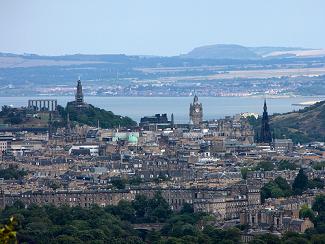Edinburgh, part 1
Edinburgh is the capital city of Scotland and the seat of the Scottish Parliament since 1437. There are four universities and several research institutes in it. It is the second (after Glasgow) biggest city in Scotland. Every year many events and festivals are conducted there. In addition, Edinburgh attracts tourists with its monuments, museums, parks, landscapes and places of entertainment.
The center of Scotland's capital city consists of the Old Town and the New Town. These two parts are separated by a beautiful Princes Street Gardens, which were created on the place of dried Nor Loch lake. In the center of Princes Street Gardens there is an artificial hill, The Mound, where National Gallery of Scotland, the Royal Scottish Academy and the Bank of Scotland are located. Tourists who come to Edinburgh during the Christmas to New Year's can observe, held in Princes Street Gardens, skating tournaments.

The Old Town is the oldest part of Edinburgh. It was built in the early Middle Ages along the Royal Mile highway, linking Holyrood Palace with Edinburgh castle. Most of the historical monuments of the city can be found in the heart of Scotland’s capital city. This including the Castle, which is considered to be the most important monument of Scotland and one of the most powerful fortresse of Great Britain. It is an example of various architectural styles. This symbol of Scotland and the UK is on the top of a rocky hill in the center of Edinburgh. Over the centuries, this building has had many different roles. It was the fortress and the seat of the rulers. The best preserved and at the same time the oldest part of Edinburgh Castle is a twelfth-century chapel of St. Margaret. Most of the castle walls are from the sixteenth century, Crown Room (Double Crown) deserves special attention from the tourists, the oldest crown jewels in Europe are stored there. It is also worth to visit the Great Hall, built by James IV, where the Scottish Parliament had debated, and Renaissance palace with octagonal turret blasting, located on the east side. Edinburgh Castle is one of a few forts in the world which have its own military garrison.
In the Old Town the Palace of Holyrood is located. It is the official Scottish residence of Queen Elizabeth II. It is situated on a hill, near the eastern end of the Royal Mile. It is surrounded by a large Royal Park. In 1128, the Abbey of Holyrood was located there. In 1498, King James IV transformed it into a beautiful palace with a huge courtyard. The present appearance of this building was created in the seventeenth century. The inner part of the Palace (so-called State Apartments) are filled with tapestries, portraits of the kings of Scotland from the seventeenth century and decorative paintings. It is worth to take a walk along the path of Radical Road, that leads to the Salisbury Crags slope, from which there is a magnificent view on the entire Holyrood.
In this part of Edinburgh we can also find St Giles Cathedral, John Knox's house (the precursor of Protestantism in Scotland) and the statue of the famous Scottish writer and poet-Walter Scott. The main street here is Roal Mile, thousands of tourists walk that street every year. It is filled with a variety of shops with typical Scottish souvenir: kilt, whiskey and crafts. Coming to Edinburgh visitors can look to a number of pubs in the Old Town, places of entertainment, and antique shops.